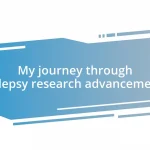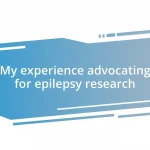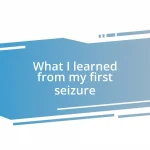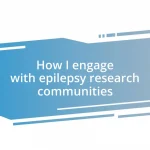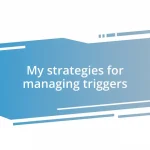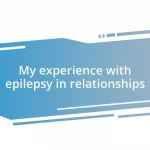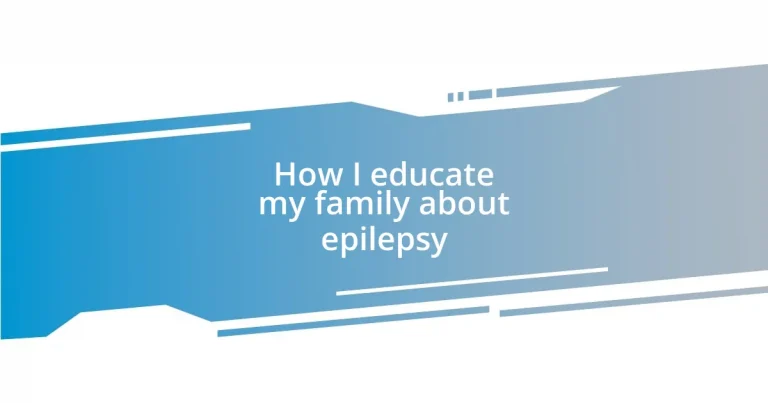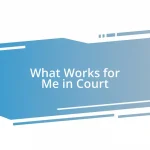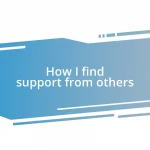Key takeaways:
- Epilepsy is a complex neurological condition that can allow individuals to lead normal lives between seizures; understanding triggers and seizure first aid is vital for support.
- Recognizing different types of seizures, such as tonic-clonic and absence seizures, empowers families to respond appropriately.
- Encouraging open communication and sharing personal experiences fosters empathy and strengthens family bonds regarding living with epilepsy.
- Engaging in supportive activities, like cooking together and creating an epilepsy plan, enhances understanding and solidarity among family members.
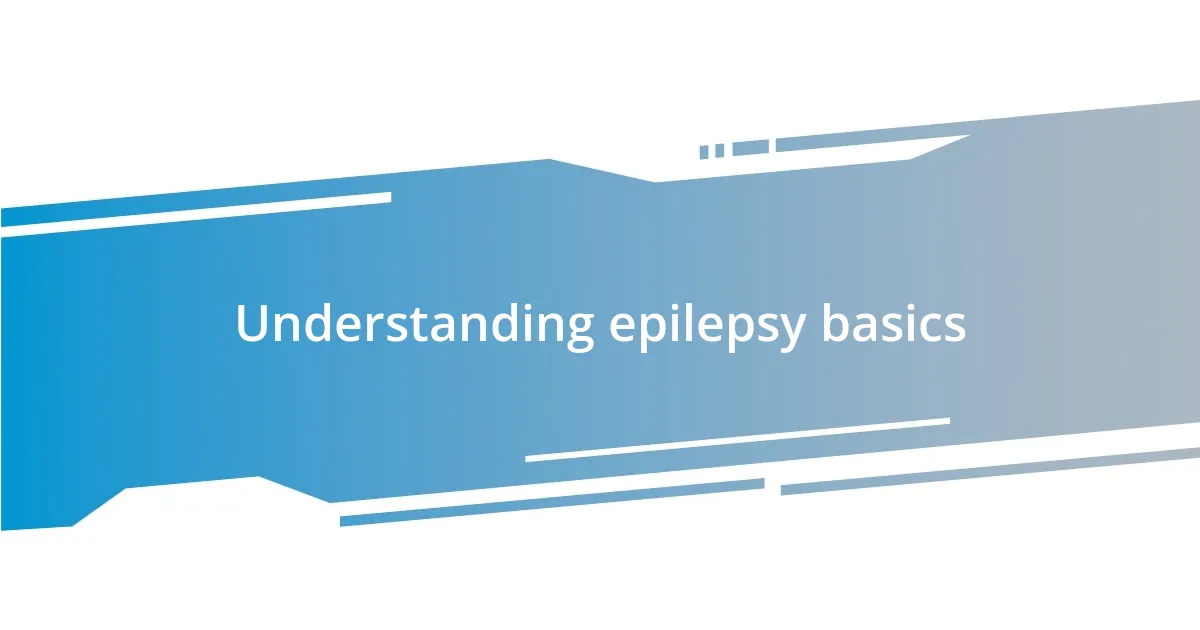
Understanding epilepsy basics
Epilepsy is often misunderstood, and I remember when I first learned about it; I thought it meant a person would always have seizures. In reality, it’s a neurological condition that affects the brain’s electrical activity, and those who have epilepsy can lead perfectly normal lives in between seizures. Isn’t it fascinating how our perceptions can be so off base?
When I explained epilepsy to my family, I emphasized that it’s not just about the seizures. I shared how triggers can vary widely—from stress to flashing lights—and that some individuals may go long stretches without any episode. This made my relatives more empathetic; they began to see the complexity behind the condition rather than just the stereotypical image of someone seizing.
One emotional moment for me was when I introduced the concept of “seizure first aid.” I asked my family what they would do if they witnessed someone having a seizure. Their puzzled looks turned to understanding as I shared that staying calm, protecting the person’s head, and timing the seizure can make a world of difference. It gave us all a sense of empowerment just to know we could help if the need arose.
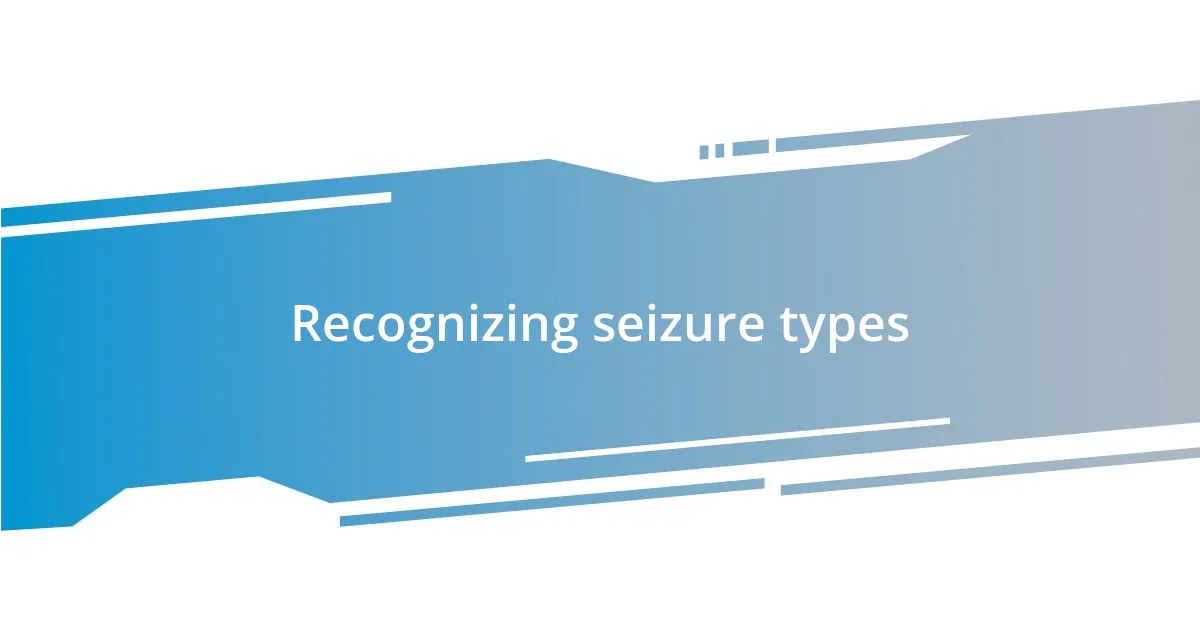
Recognizing seizure types
Recognizing the different types of seizures is incredibly important, especially for families like mine who want to offer support. I remember the first time I witnessed a tonic-clonic seizure—previously, I had only read about it. The sheer intensity was shocking, but understanding that this was just one type helped me process what I was seeing. Identifying the signs and symptoms of each seizure type empowers families to respond appropriately and with confidence.
When discussing seizure types, I often mention absence seizures, which can be subtle and easily overlooked. I realized this when my younger sibling had them during class, and no one seemed to notice. It made me understand how critical it is to recognize these moments, as they can appear like daydreaming. Knowing there are diverse presentations of seizures allows families to be more vigilant, creating a supportive environment for individuals with epilepsy.
To further illustrate the differences among seizure types, I found that a comparison table could be quite helpful. This allows for a quick reference that encapsulates the various characteristics of seizures.
| Seizure Type | Characteristics |
|---|---|
| Tonic-Clonic | Generalized seizures, convulsions, loss of consciousness |
| Absence | Brief lapses in awareness, often mistaken for daydreaming |
| Focal | Localizes to one area of the brain; symptoms vary widely |
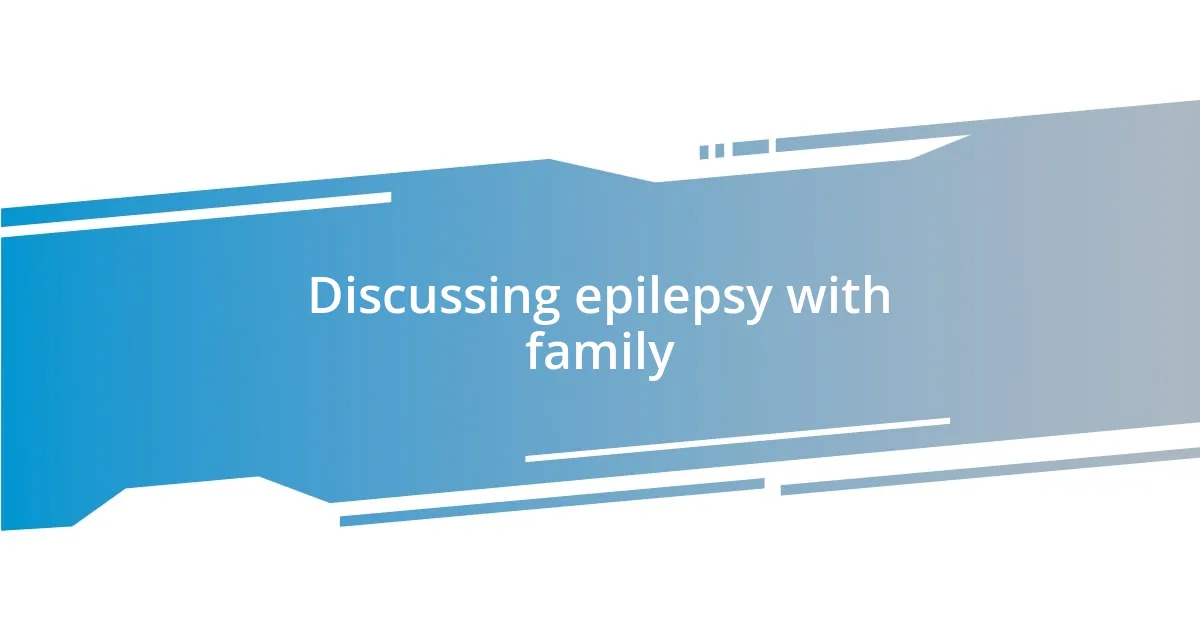
Discussing epilepsy with family
When I first sat down to discuss epilepsy with my family, I felt a mix of anxiety and hope. I wanted to convey the realities of living with the condition without overwhelming them. It was essential for me to present it as a part of my life rather than a defining factor. By sharing my experiences and feelings, I could build that emotional bridge. They realized that my journey includes both challenges and victories, and that understanding epilepsy is a crucial step in supporting me.
Here are some key points that helped facilitate our discussion:
- Personal stories matter: I shared moments when I felt anxious before an event, unsure of how my epilepsy might affect my experience.
- Room for questions: I encouraged my family to ask questions, no matter how simple they felt, to create an open dialogue.
- Empathy over fear: Emphasizing the importance of empathy, I helped them see how their support could make a difference in my daily life.
- Normalize the conversation: I reminded them that discussing epilepsy shouldn’t be a taboo topic but rather a natural part of understanding my needs.
- Invite them to learn: I suggested resources for them to read or watch to deepen their understanding, turning education into a shared journey.
Encouraging this kind of dialogue transformed the way my family approached epilepsy. It changed the atmosphere from confusion and concern to one of informed compassion. This empowerment not only informed them but also strengthened our bond.

Resources for educational materials
One fantastic resource I found helpful was the Epilepsy Foundation’s website. They offer a wealth of educational materials, from downloadable booklets to webinars, all designed for various audiences. I remember using their seizure diary template to help my family track my seizures. It not only provided them with valuable insights but also turned into a project that strengthened our teamwork. Isn’t it fascinating how a simple tool can pull us closer together?
Another invaluable resource came from books specifically geared toward understanding epilepsy. For example, I stumbled upon “Epilepsy: A Guide for Patients and Families.” It was a game changer, as it broke down complex medical jargon into relatable language. My parents and I would read chapters together, and I could see their eyes light up with understanding. Sharing those moments of revelation made the learning process feel less daunting and more like an adventure we were all on together.
Lastly, I can’t stress enough the importance of connecting with local support groups or forums. I vividly recall attending a community meeting where families shared their experiences. Hearing others talk about their journeys gave my family context and depth to my own experience. Have you ever been in a room full of people who truly understand? Those shared stories fostered a sense of belonging that textbooks simply can’t provide. Utilizing resources like these transforms the conversation around epilepsy into something approachable and relatable for everyone involved.
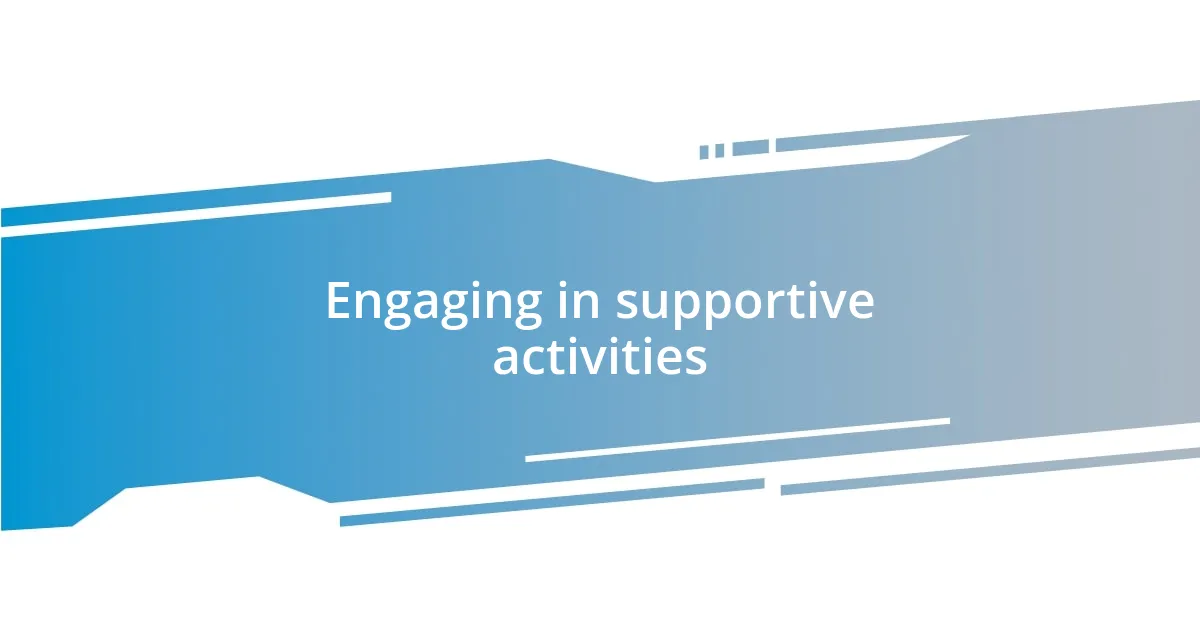
Engaging in supportive activities
Engaging in supportive activities has been a transformative part of how my family and I navigate my epilepsy together. One activity we found particularly meaningful was cooking meals together, emphasizing healthy ingredients that are good for brain health. As we chopped vegetables and stirred pots, we chatted about the importance of nutrition in managing my condition. It was amazing to see their interest grow as they became more involved in my well-being. Have you ever noticed how sharing a meal can foster open conversation?
Participating in community walks for epilepsy awareness also brought us closer. It started as a way to show support, but it quickly turned into a bonding experience. I can still remember my family’s excitement as we donned our matching shirts, sharing smiles and stories with other participants. The atmosphere was electric, filled with hope and shared experiences. This interactive involvement allowed my family to see firsthand the broader community of support, helping to destigmatize epilepsy. Don’t you think experiencing solidarity in action can be a powerful motivator for understanding?
Another impactful activity was creating a family “epilepsy plan” together. We gathered around the table to discuss how they could assist me during a seizure or what to do in various situations. It was quite nerve-wracking for me initially; there were moments when I had to confront my vulnerabilities. But as we laid out scenarios and roles, I felt a wave of relief wash over me. Their willingness to engage and learn made me realize that I’m not alone in this journey; we’re all in it together. Isn’t it reassuring to have a proactive approach in a situation that can feel so unpredictable?
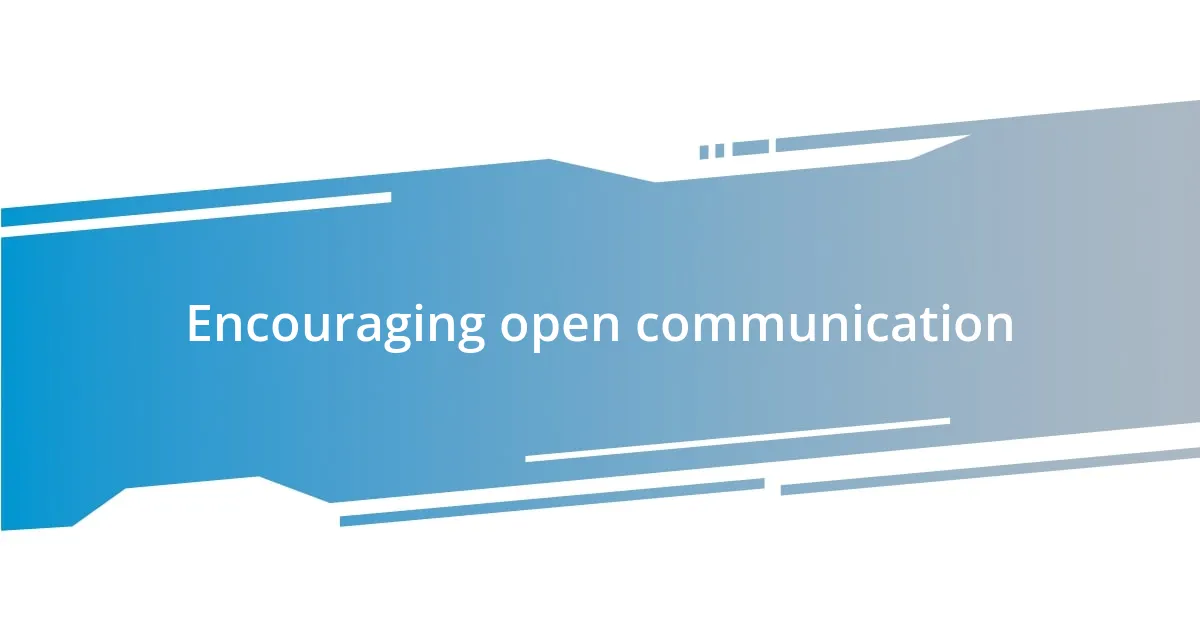
Encouraging open communication
Encouraging open communication has been key for my family and me. I remember one evening when we sat down after dinner and just started talking. I opened up about what it feels like to have a seizure, and to my surprise, my parents shared their thoughts and fears too. This honest exchange was like lifting a weight off my shoulders; it made me realize that my experiences were as important to them as they were to me. Don’t you think vulnerability can bridge gaps in understanding?
One practice that really brought us together was a weekly “check-in” where we dedicated time to discuss how I was feeling and any concerns they might have. These little sessions allowed them to voice their questions about my epilepsy without fear of judgment. We always ended our chats with laughter or a lighthearted comment, which kept the mood positive. I’ve found that creating this safe space fosters an environment where everyone can speak freely. How powerful is it to have a family that listens?
Finding the right moment to discuss topics can be challenging but totally worthwhile. For instance, during a family movie night, we took a break to talk about epilepsy when a character in the film experienced a seizure. It was a casual setting, which made it easier to address something serious. My siblings asked questions, and I shared some of my experiences. This organic way of talking made it feel less intimidating for all of us. Sometimes, the best conversations arise when you least expect them, don’t you agree?
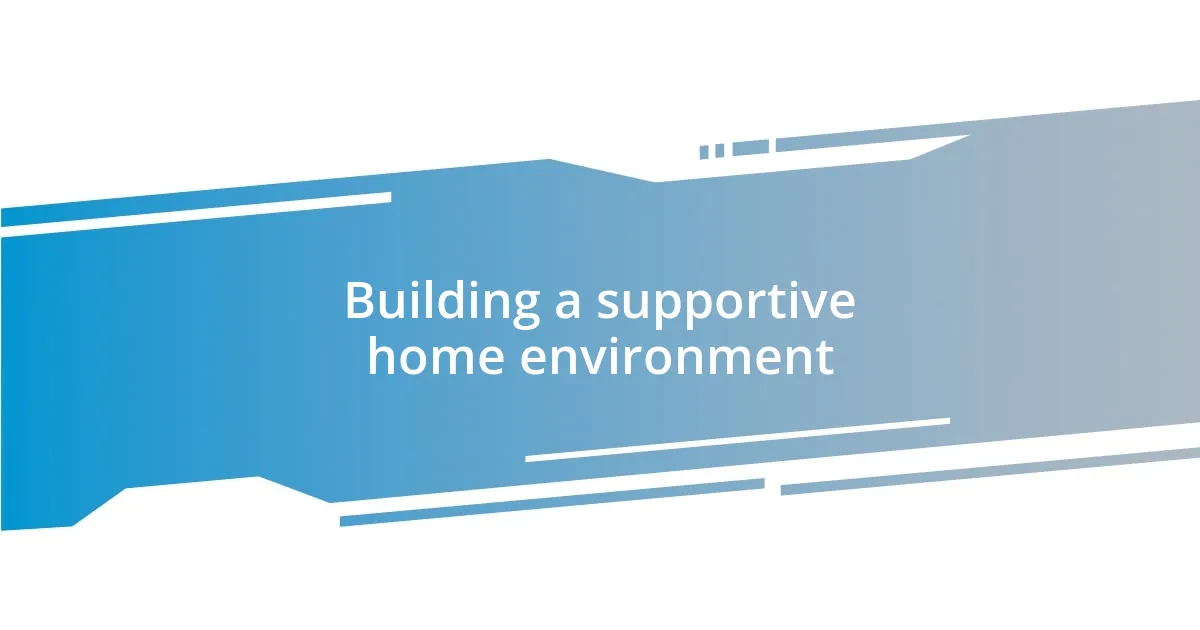
Building a supportive home environment
Building a supportive home environment around epilepsy starts with understanding each other’s emotions. I remember one afternoon when my family and I rearranged the living room to create a cozy movie corner specifically for our family film nights. As we moved the furniture, we chatted about how soothing it could be to have a relaxed space to unwind, especially when I felt overwhelmed. It struck me that these small, thoughtful changes could significantly impact my peace of mind. Isn’t it amazing how our surroundings can influence our feelings and sense of security?
Another pivotal element in crafting a supportive atmosphere is implementing practical adjustments. For instance, we decided to create a designated “safe zone” in our home. This area included soft cushions and calming visuals, which would be my go-to place during moments of stress or when I felt a seizure might occur. When I first suggested it, my family’s eagerness to collaborate on making it comfortable overwhelmed me with gratitude. How comforting is it to know that you have a physical space dedicated to your well-being?
Lastly, I’ve seen the value in creating a routine that incorporates rest and relaxation. We set a family rule of “no screens one hour before bed,” promoting healthier sleep habits for everyone. I still cherish those quiet moments when we’d gather with a book or take time for light yoga together. It felt incredibly nurturing to share these practices, cultivating an atmosphere of care and awareness. Don’t you think establishing these routines can strengthen family bonds while supporting a loved one’s health?
